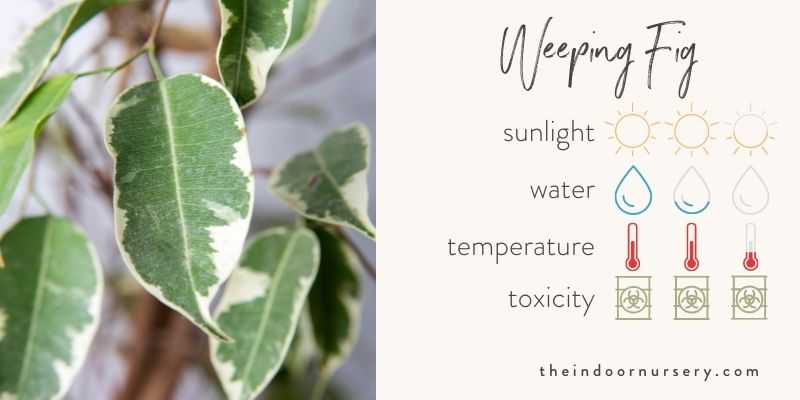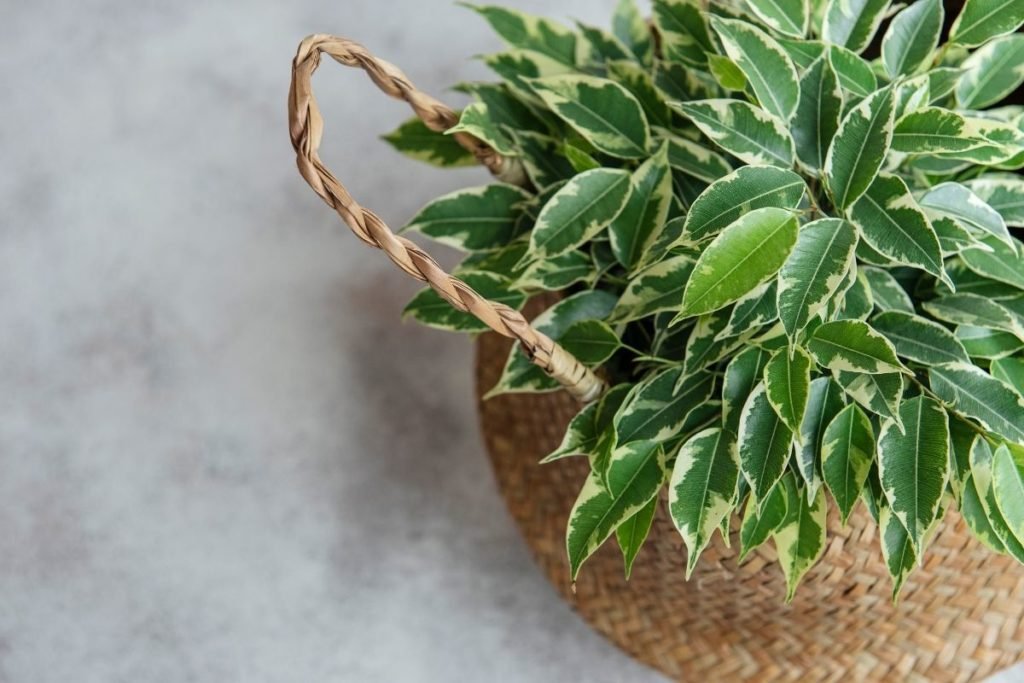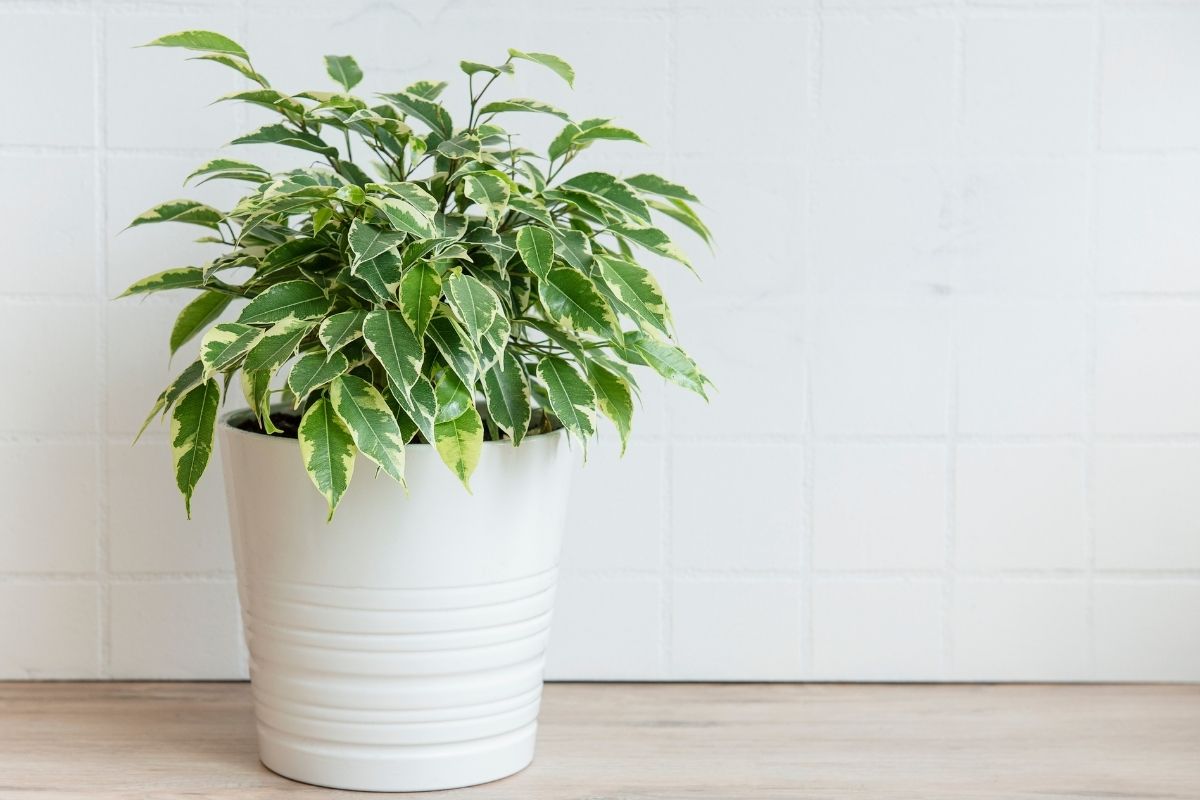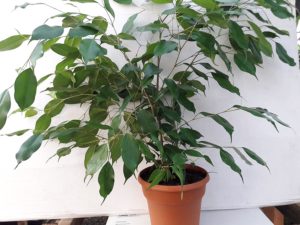Plant description
The Ficus Benjamina plant (Weeping Fig) is known for its dreamy tuft of glossy leaves and branches and trunk that are often trained into elegant shapes. In its native environment, the Ficus Benjamina can grow up to 60 feet.
Indoors, the Ficus Benjamina tree can be cultivated as a small bonsai tree or larger houseplant, growing up to 6 feet indoors.
The Ficus Benjamina is part of the Moraeae family, which is native to Asia and Australia. It falls under the Ficus genus, which includes popular plants such as the Rubber Tree and Fig Tree grown for fruit.
Plant facts
| common name | Ficus Tree, Weeping Fig, Benjamin Fig, Java Fig, Waringin, Weeping Ficus, Weeping Fig Tree |
| botanical name | Ficus Benjamina |
| no. of varieties | 8-10 |
| family | Moraeae |
| biological life cycle | annual |
| foliage | evergreen |
| mature size | 3-6 feet indoors ; 8-13 feet tall by 5-8 feet wide outdoors |
| time to maturity | 2-3 years |
| origin | Asia and Australia |
| light conditions | bright, indirect sunlight |
| soil type | loam-based, well-draining |
| soil pH | acidic to neutral |
| USDA Zone | 10-11 |
| toxicity | moderately toxic to people and pets |
Popular varieties
Golden King, Starlight, Exotica, Monique,Reginald, Natasha, Kinky, Wiandi.
How to take care of a ficus benjamina
Once situated in an ideal environment, the Weeping Fig is an easy plant to care for. The Ficus Benjamina is sensitive to shifts in temperature and light, but with the proper attention and care, the Weeping Fig can live for decades.
Light 🔆
Best light: bright, indirect sunlight
The Ficus Benjamina should be placed in bright, indirect light to partial shade.
Make sure to avoid placing your Ficus Benjamina in full sun as the foliage will burn. Leaves will typically become waxy or pale and begin dropping when exposed to too much light, signaling stress.
Water 💧
Water requirements: keep soil moist in warmer months, let it dry out slightly in colder months
The Ficus Benjamina Tree should be watered frequently during the growing season in spring and summer months. Keep the soil moist for best results. During colder months, allow the soil to dry out slightly between waterings.
If water drains fully through the pot and pools in a saucer beneath the post, be sure to drain this as the Ficus Benjamina does not like to sit in water.

Humidity 🌫️
The Ficus Benjamina fares well in average humidity environments, but does prefer higher humidity as it is native to tropical environments.
Mist your Ficus Benjamina regularly or place a pebble tray filled with water close to the pot to increase humidity in the area. Although the Ficus Benjamina enjoys higher humidity, make sure not to over-water the plant.
Temperature 🌡️
The Ficus Benjamina does best in steady temperatures between 65°F(18°C) to 85°(29°C) during the day. Keep your Weeping Fig away from vents or drafty windows, as fluctuating temperatures cause ficus leaves to drop.

Fertilizer 💩
Fertilizer preferences: The Weeping Fig is a rapid-grower and loves a regular dose of plant fertilizer. Use a 10-10-10 fertilizer once a month in the growing season (spring and summer), and once every two months in the fall and winter.
You can also use slow-release fertilizer pellets to ensure your Weeping Fig gets the nutrients it needs. Simply place the pellets (follow dosage according to the specific brand you choose) a few inches into the soil at the beginning of growing season and water as usual.
Soil
soil type: loam-based, well-draining
pH level: acidic to neutral
Although ficus trees are somewhat drought-tolerant, they do best with moderate soil moisture as well as rich, fast-draining potting soil. Weeping Figs do not necessarily need soil with heavy amounts of organic matter. Look for a neutral to acidic loam-based compost mix containing vermiculite and sand.
Repotting
The Ficus Benjamina does not mind being a little root-bound before repotting. The new container should be about 2 inches larger in diameter. A container that is much larger in size than a previous pot can stunt the plant’s growth. The best time of year to repot your Ficus Benjamina is late winter or early spring, before new growth starts. Be sure to use a well-draining potting soil.
Propagation 🌱
The easiest way to propagate Weeping Fig is by taking stem cuttings. Do this in the Spring when there is ample warmth and humidity to increase the likelihood that your cuttings will take root.
Rooting Weeping Fig in Water
- Cut about 6 inches of a mature branch at least ¼” below a leaf node
- Strip leaves from the bottom 2-3 inches of the cutting, ensuring 3-6 leaves remain
- Place the cutting in water, and wait for new roots to grow
- When new roots have grown to roughly 4 inches, place the cutting in a new pot with a fine potting mix
Rooting Weeping Fig in Soil*
- Cut about 6 inches of a mature branch at least ¼” below a leaf node
- Strip leaves from the bottom 2-3 inches of the cutting, ensuring 3-6 leaves remain
- Place the cutting into a small pot with fine, fresh potting mix, and water
- Cover the new cutting with a medium-sized plastic bag to trap moisture and warmth
- After 2-3 weeks, cut several holes in the bag to allow the plant to acclimate to room temperature
- Once roots are firmly established, remove the bag entirely and water as instructed above.
*As an option, treat both the fresh cutting and the mother plant with rooting hormone to encourage new growth.

Pruning 🌿
Pruning is an essential part of any care routine for Ficus Benajmina when growing this plant as a bonsai. Because the Weeping Fig grows quickly, pruning also helps to limit the size of this plant. As when taking cuttings for propagation, cut branches at least 1/4 inch down from a leaf node (where leaves join a branch). The best time to prune a Weeping Fig is in colder months, when it’s dormant.
Remove dead branches and leaves at any time of year to direct the tree’s energy to its living limbs and leaves.
Pests and diseases 🐛
Pests: whitefly, mealybug, spider mite, and scale
Disease: leaf loss
The Ficus Benjamina occasionally falls pretty to common house pests such as whitefly, mealybug, spider mite, and scale.
If you notice a sticky liquid or sap is dripping from the Weeping Fig, this is a sign of scale infection. Scale bugs excrete this liquid when feeding on the Weeping Fig, and it’s common to notice this residue before scale bugs.
Treat scale and other pests with insecticidal soap or Neem oil. It’s likely a few applications will be needed to fully rid the tree of pests, especially if you first begin treating the plant when you notice residue.
The Weeping Fig loses leaves when stressed. Under-watering, over-watering, low humidity, insufficient light, drafts, change in temperature, pests, or repotting can all trigger a leaf drop.
Don’t stress if your Ficus Benjamina loses a few leaves now and then, but do make sure you know why it’s happening.
Ficus benjamina plant care tips
1. Ficus Benjamina can grow outdoors in USDA hardiness zones between 10 and 11.
2. If leaves are dropping at excessive levels with ideal lighting, humidity, and temperature, adding a little liquid magnesium and manganese to its soil can help.
Common Problems / FAQs:
1. Sticky substance coating the foliage
→ This could be an infestation of scale that causes leaves to release honeydew. An insecticidal soap or Neem oil can help rid scale from the ficus. Alternatively, a rapid change in humidity can cause a process called guttation (essentially moisture loss through leaf-tips) to occur, which can be sticky depending on the time of year and condition of the plant. If guttation persists for a number of days, reduce the amount of water you give this plant.
2. Dry and shriveled up leaves
→ This could be a result of low humidity. Add humidity through frequent misting, a humidifier, or a pebble tray with water placed close to the ficus.
latest in houseplant care
- Rubber Plant Care: How To Take Care Of Rubber Plants
- Growing ZZ Plants: How To Care For A ZZ Plant
- How To Get Rid Of Scale On Plants
- How Often To Water Dracaena (Including Snake Plants)
- How to Use Leca for Plants: Step-by-Step Guide with Pictures
- How To Save An Overwatered Snake Plant
- Hoya Carnosa Care Tips: How To Care For Hoya Carnosa






Hey, Marcia! Thanks for reading :) gosh, that's a great idea to double up on your watering globe and spike.…